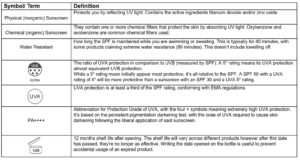To learn more, follow us on our social media channels.
Instagram|Facebook|Twitter|LinkedIn
While it is a ubiquitous number present on skincare products worldwide, the concept of Sun Protection Factor (SPF) is poorly understood and widely misinterpreted.
In short, SPF is a standardised measure of the additional length of time your skin can be exposed to UV light (from the sun or artificial sources) before burning. Depending on our genetics and skin pigmentation, individuals will be able to withstand varying sun intensities before burning. A person with fair (Caucasian) skin, for example, will naturally be more photosensitive than a person of direct African descent.
The number associated with SPF is a multiplier of the amount of time in which your skin would otherwise burn, assuming the product is being used correctly. For example, an SPF of 20 means a person who usually could withstand 10 minutes unprotected in sunlight before showing signs of sunburn would now be able to withstand 200 minutes.
However, SPF only measures how well a sunscreen protects against UVB rays (280 – 310nm), not the full spectrum of light emitted by the sun. Both UVB and UVA (310-400nm) radiation chronically damage our skin, causing premature photoaging and, more significantly, life-threatening skin cancer. Additionally, no sunscreen can block all UVB light from penetrating into our skin. UVB will thus still cause some damage to the skin despite sunscreen use, however, this is extremely minor (an SPF 30 blocks 97% of UVB while an SPF 50 blocks 98% of UVB).
In 1998 the FDA approved the first sunscreen containing a UVA specific filter. Various sunscreens containing combinations of both UVB and UVA filters – otherwise known as broad-spectrum sunscreens – have since been created. Despite this, a global standard for UVA filters has yet to emerge, with numerous regional UVA specific labelling specifications and symbols (see the table below).
The first rule of sunscreen is to use it regularly. UV damage is cumulative, meaning even brief exposure without protection will have an effect later in life. Applying a quantity equivalent to one teaspoon to each limb as well as a teaspoon to the face and neck is sufficient to ensure adequate UV protection. Sunscreens must be reapplied every two hours as they naturally breakdown when exposed to sunlight.

